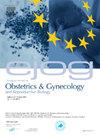A scoping review of decision aids for pregnant women around childbirth: Do they improve decision quality, processes, and outcomes?
IF 2.1
4区 医学
Q2 OBSTETRICS & GYNECOLOGY
European journal of obstetrics, gynecology, and reproductive biology
Pub Date : 2025-05-25
DOI:10.1016/j.ejogrb.2025.114085
引用次数: 0
Abstract
Background
Meaningful engagement of women in childbirth decisions is a growing priority in maternity care. Decision aids are tools designed to improve decision quality, decision-making processes quality, care behaviours, and health outcomes (quadruple aim).
Objective
To map quantitative studies evaluating the effects of decision aids for women making decisions around childbirth.
Methods
We searched MEDLINE, Cochrane DSR and CENTRAL, CINAHL, and EMBASE (January 1975–April 2025) for reviews, randomized controlled trials and controlled before-and-after studies that assessed the effect of decision aids for childbirth decisions.
Results
28 studies (11 reviews, 17 primary studies) met selection criteria. Most involved high-risk pregnant women and showed that decision aid improved the quality of decision and decision-making process. Positive impacts on care behaviour and health outcomes were more evident when decision aids were combined with other components and required discussions with healthcare providers.
Discussion
Although limited, evidence suggests decision aids are more effective when women are prepared to use the tool and healthcare providers are actively involved. The review identified gaps in research targeting low-risk women in low- and middle-income countries and assessing women’s value and preferences for shared decision-making.
Conclusions
Decision aids around childbirth have the potential to meet women’s needs in decision-making, appropriate use of care and perinatal health outcomes especially when they are prepared to use the tool and supported by healthcare providers. Future research should evaluate all four aim objectives to strengthen the evidence on the benefits of decision aids, especially for low-risk population and in low- and middle-income countries.
对孕妇分娩前后决策辅助工具的范围审查:它们是否改善了决策质量、过程和结果?
在产妇护理中,妇女有意义地参与分娩决策日益成为一个优先事项。决策辅助工具是旨在提高决策质量、决策过程质量、护理行为和健康结果(四重目标)的工具。目的通过定量研究评估决策辅助工具对妇女分娩决策的影响。方法:我们检索MEDLINE、Cochrane DSR和CENTRAL、CINAHL和EMBASE(1975年1月- 2025年4月),获取评估辅助分娩决策效果的综述、随机对照试验和前后对照研究。结果28项研究(11项综述,17项初步研究)符合入选标准。大多数涉及高危孕妇,并表明决策辅助提高了决策质量和决策过程。当决策辅助与其他组成部分相结合并需要与医疗保健提供者进行讨论时,对护理行为和健康结果的积极影响更为明显。讨论尽管有限,但证据表明,当妇女准备好使用决策辅助工具并且医疗保健提供者积极参与时,决策辅助工具更有效。该审查确定了针对低收入和中等收入国家低风险妇女的研究以及评估妇女对共同决策的价值和偏好方面的差距。结论分娩决策辅助工具有可能满足妇女在决策、适当使用护理和围产期健康结局方面的需求,特别是当她们准备好使用该工具并得到卫生保健提供者的支持时。未来的研究应评价所有四个目标,以加强关于决策辅助的益处的证据,特别是对低风险人群和中低收入国家。
本文章由计算机程序翻译,如有差异,请以英文原文为准。
求助全文
约1分钟内获得全文
求助全文
来源期刊
CiteScore
4.60
自引率
3.80%
发文量
898
审稿时长
8.3 weeks
期刊介绍:
The European Journal of Obstetrics & Gynecology and Reproductive Biology is the leading general clinical journal covering the continent. It publishes peer reviewed original research articles, as well as a wide range of news, book reviews, biographical, historical and educational articles and a lively correspondence section. Fields covered include obstetrics, prenatal diagnosis, maternal-fetal medicine, perinatology, general gynecology, gynecologic oncology, uro-gynecology, reproductive medicine, infertility, reproductive endocrinology, sexual medicine and reproductive ethics. The European Journal of Obstetrics & Gynecology and Reproductive Biology provides a forum for scientific and clinical professional communication in obstetrics and gynecology throughout Europe and the world.

 求助内容:
求助内容: 应助结果提醒方式:
应助结果提醒方式:


